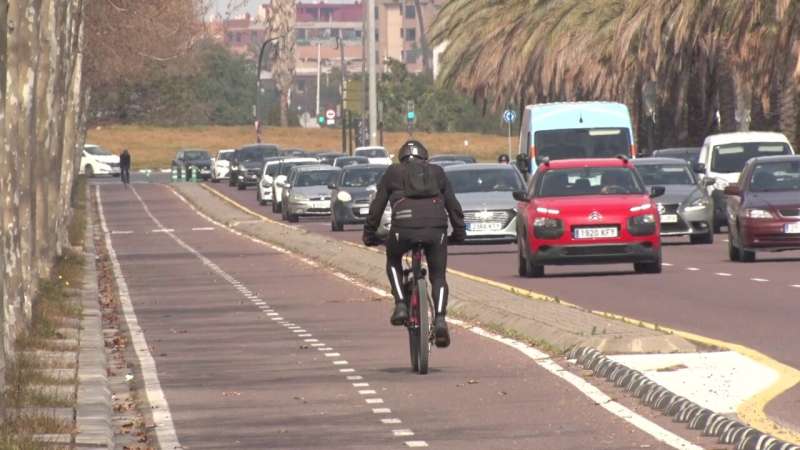Researching the basics for safer bike lanes
Improving safety in bike lanes is the aim of a recent study by the Highway Engineering Research Group (HERG) of the Universitat Politècnica de València (UPV). Their research analyzes the skid resistance of five types of pavements—asphalt pavement, concrete pavement, smooth and rough painted tiles, and cobble pavement—at seventeen locations in Valencia city.
Among the conclusions, the study notes the risk of painted cobble and smooth painted tile pavements, warning that they “should not be used due to their low and variable skid resistance, as well as the high vibrations they cause to users.” The paper has been published in Sustainability.
According to the study’s authors, the new mobility has increased crashes involving users, mainly bicycles and electric scooters. Many of these crashes are falls in which only the user is involved, i.e., single-bicycle crashes (SBCs).
In 2018, the number of crashes involving personal mobility vehicles in urban areas was less than 200 -199, to be precise- and in 2021, this number rose to 2541. In the case of bicycles, the number of crashes was relatively stable over this period, rising from 5384 to 5712. During 2021, the latest year for which official data is available, 27% of these crashes occurred while riding an electric scooter or bicycle without interaction with other road users.
“Most of the time, these crashes happen because the pavement was slippery. Therefore, studying the pavement’s skid resistance is crucial to improving safety on bike lanes. This resistance is one of the characteristics that most affect safety, as it has a decisive influence on accelerating, braking, and keeping the trajectory of a bicycle or e-scooter while turning, without the risk of slipping or skidding,” explains David Llopis Castelló, a researcher at the HERG-UPV.
Thus, among the different pavements analyzed, the HERG-UPV has found that asphalt, concrete, and rough tile pavements provide adequate skid resistance. In particular, the first two offer the best performance, as they generate less vibrations and, therefore, a more comfortable ride.

“On the other hand, painted cobble and smooth painted tile pavements do not meet the requirements, and the probability of falls, collisions, and conflicts between cyclists, e-scooter users, pedestrians, and motorized traffic is higher,” says Ana María Pérez Zuriaga, also from the HERG-UPV.
In its study, the HERG-UPV also measured the speed of users of bicycles and electric scooters to analyze their behavior and the influence of pavements on stopping sight distance. In conclusion, the pavements that provide greater adherence—asphalt, concrete, and rough painted tile pavements—allow a reduction in the required stopping sight distance of up to 7.5%, while smooth painted tile pavements increase this distance by 7% when traveling at 20 km/h (speed limit in bike lanes), with the consequent risk.
Good practice
Based on this research, the study carried out by the Highway Engineering Research Group proposes that asphalt should be used as the paving material on roads shared by motorized vehicles and users of bicycles or electric scooters, as well as on striped/buffered bike lanes. The same applies to protected bike lanes, although concrete pavement may also be used for these. For sidepaths, rough tile pavement is the best option, as the vibrations experienced by users may encourage them to slow down.
In addition, the study proposes the minimum stopping sight distances required to ensure safety not only for cyclists and e-scooter users but also for pedestrians and motorized vehicles.
“The results of this study can serve as a basis for designing a safer micromobility infrastructure. In the choice of pavements for newly constructed bike lanes, it is essential to consider a parameter such as skid resistance, always accompanied by preventive inspection during pavement service life,” concludes Alfredo García García, coordinator of the Highway Engineering Research Group at Universitat Politècnica de València.
More information:
Martín López-Molina et al, Skid Resistance Analysis of Urban Bike Lane Pavements for Safe Micromobility, Sustainability (2023). DOI: 10.3390/su15010698
Provided by
Universitat Politècnica de València
Citation:
Researching the basics for safer bike lanes (2023, February 28)
retrieved 28 February 2023
from https://techxplore.com/news/2023-02-basics-safer-bike-lanes.html
This document is subject to copyright. Apart from any fair dealing for the purpose of private study or research, no
part may be reproduced without the written permission. The content is provided for information purposes only.
For all the latest Technology News Click Here
For the latest news and updates, follow us on Google News.
